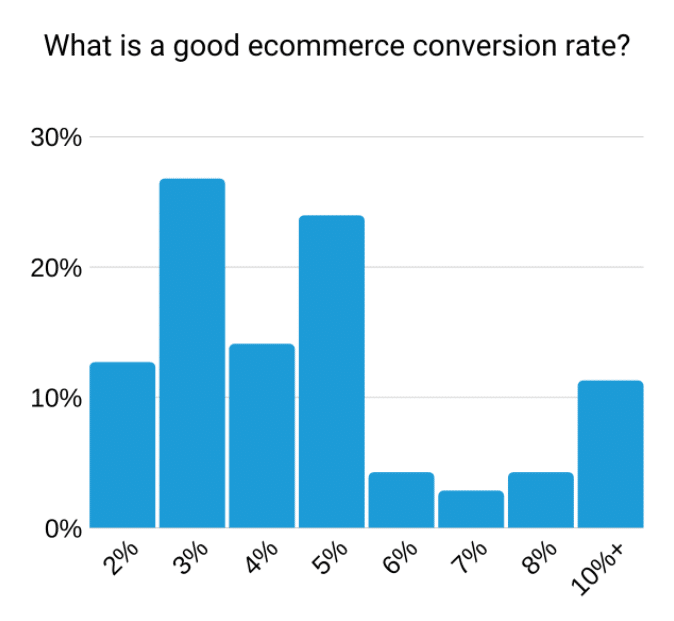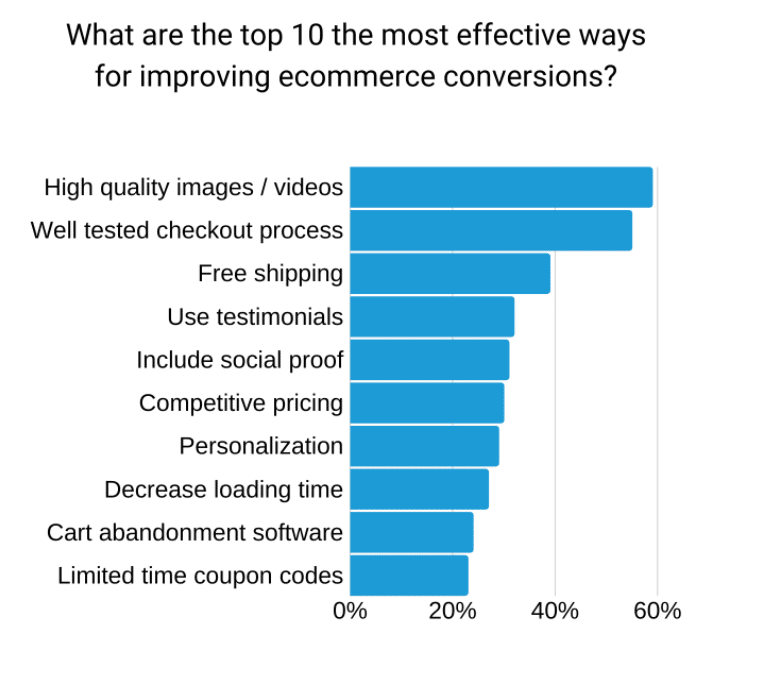To increase ecommerce conversion rate, focus on site speed, mobile UX, and frictionless checkout. Personalization, trust signals, and A/B testing can further improve the path to purchase and boost overall revenue.
Your ecommerce conversion rate is one of the most important KPIs that you can track on your ecommerce site. It’s a crucial metric that objectively measures the success of your online business based on the number of transactions per session.
In a nutshell, it tells you how many visitors you’re turning into customers. Having a low ecommerce conversion rate means there’s something stopping your site visitors from making a purchase, leading to missed opportunities and lost profits. Luckily, there are several ways to increase the conversion rate of your online business.
What is an ecommerce conversion rate?
Your ecommerce conversion rate is simply the ratio between the total number of visits to your website and the total number of transactions made, i.e. the number of purchases. It’s also the most crucial metric you want to be measuring when running an online store, because it tells you how many of your site visitors are converting into paying customers.
By measuring your conversion rate at regular intervals, whether that’s weekly, monthly or quarterly, you’ll be able to gauge the long term success of your ecommerce business – and make improvements to your current conversion rates.
You can also use more detailed analytics that identify the traffic source of your paying customers, like whether they clicked through from a particular ad campaign, a social media post, or a keyword search result on Google.
Having this kind of information is important because it shows you which platforms have the highest conversion rates, allowing you to target these more strategically. Similarly, it will show you which platforms have the least conversions so that you can cut them from your ecommerce marketing strategy – why waste money on tactics that aren’t working?
I have said many times, every month we go through content ideas and review all the details. I think there’s no way we’re going to out do or come up with anything this good next month, and every time LimeLight comes up with something just as good if not better.
Shelley Espelien, Owner, Creative Candles
What is a good conversion rate for ecommerce?
On average, a good conversion rate for ecommerce is between 1% and 3%, with the average webpage converting at around 2.35%. Numbers aside, a good ecommerce conversion rate should have a high return on investment (ROI) so that you’re continually earning. This simply means that the revenue your business generates should be higher than the budget you’ve used to promote it.
However, in reality, you may only be achieving a break-even revenue, or even negative profits. That’s when you know you need to look at how your conversion rates are performing, and put measures in place to improve them. Facilitating a good conversion rate takes time and strategic planning, and it can also be affected by the competitiveness of your industry. This is why it’s important to do some research and figure out what a good conversion rate means in your sector of work.
The average ecommerce conversion rate varies depending on industry and product. For example, the average conversion rate in the retail sector is around 3%, and it ranges from 1.4% for consumer electronics to 4.9% for gifts. Knowing your industry’s average ecommerce conversion rate will give you insights on how to refine your marketing campaigns for better success.

How to calculate your ecommerce conversion rate
To calculate your ecommerce conversion rate, you simply need to divide the total number of conversions you make (i.e. the number of times a customer makes a purchase) by the number of visitors to your website over a set period. You then multiply this number by 100 to get the percentage.
For example, if you had 10,000 visitors to your site one month, and 500 of those ‘converted’ or bought something, your conversion rate would be 5%.
You can also calculate your conversion rate based on certain categories to see which ones have the most success. For example, you can measure individual conversion rates for:
- Different types of products, to see which sell the best
- Traffic sources, to see which marketing channels you’re using bring in the most revenue
- Location of the customer, to see where in the country (or world) they are located
- Social media platforms, to see which ones your customers use the most
- Keyword search, to see which phrases you should be targeting
How to improve ecommerce conversion rates
To increase your ecommerce conversion rate (and therefore your sales), you’ll need to gather relevant data from your site analytics so that you can identify and target the online preferences of your ideal customers. Understanding how your customers behave when they’re on your site will allow you to optimize your ecommerce conversion rate.
You can work out what your customers are doing on your site (and therefore where you might be able to make improvements or funnel them in the direction you want them to go in) in a few different ways. You’ll get a lot of data from Google Analytics to start with, and you can create handy, regular conversion rate reports that will allow you to more easily analyze the data. There are other great tools you can use, too. We like HotJar, which offers a variety of ways to see what visitors are doing on your site. The best of these is the heatmap, which shows you whereabouts on a page your customers are clicking.
Understanding this type of behavior allows you to optimize your ecommerce conversion rates by making specific changes to your site. For example, if you see a lot of clicks on one particular link, you might decide to make more of that link, perhaps by moving it up the page and making it more prominent.
8 tips for ecommerce conversion rate optimization
The number one way to improve ecommerce conversion rates is to make sure your website as a whole is optimized. The two go hand-in-hand, because while you might be getting a lot of site visitors, they are unlikely to convert if your website doesn’t provide a first-class, user-friendly experience. Here are our top eight tips on how to optimize your website, and therefore improve your ecommerce conversion rate:

- Make your website user-friendly: If your website takes more than four seconds to load, you’ll lose potential customers. Similarly, if your website is disorganized, confusing, or unattractive, your bounce rate will be high. Using a UX (user experience) design that’s fast, easy to navigate, and gets to the point is the easiest way you can begin optimizing your ecommerce conversion rate.
- Know your audience: You must understand your target audience if you want them to respond to your business. Use analytics to gain a clear understanding of what they want and need so that you can tailor your site content to their interests. This will help them feel an immediate affinity with your brand when they click onto your online store.
- Optimize your online shop for all devices: In addition to making your website fast and user-friendly, it must also be responsive to all devices, from desktops and laptops to tablets and smartphones. For example, the layout and content should adjust to different screen dimensions and aspect ratios to ensure that every user has an optimized experience.
- Be informative about your products: Take time to create longer and more informative product content that will establish trust with your site visitors. It could be an article about your product that will help customers understand its features, an FAQ video that answers important questions, or even an interactive quiz that will help users choose a product. Whatever type of content marketing you use, be persuasive, use verifiable facts, and always appeal to your customers’ emotions.
- Call to action (CTA): Have a clear and concise CTA that motivates your leads to make a purchase, subscribe to your newsletter, book an appointment, or fulfill any other goal your ecommerce website has. CTAs should point users to product pages, or places where they’re likely to convert, and should be strategically placed throughout your website so that they’re not overwhelming, but come in the right place at the right time.
- Simplify the checkout process: It’s very common for online shoppers to abandon their shopping carts, especially when the checkout process is too complicated or takes too long. Try to minimize any extra hassle during checkout, like arduous form-filling or awkward payment options. To streamline your online store’s checkout process as much as possible, provide a one-tap sign up option by integrating social media logins, and offer as many popular payment options as possible, like Visa, Stripe, Paypal, Google Pay, or the up-and-coming Klarna.
- Establish trust: Avoid using hard sell techniques when running your ecommerce business. In fact, these have gone into rapid decline given their aggressive and impersonal nature. Instead, establish rapport and trust with your leads by building a friendly and approachable brand that clearly values its customers. You should also be helpful in terms of providing useful content that’s related to the product you’re offering so that customers view you as an authoritative and trustworthy source.
- Be interactive: Providing a personalized and interactive experience is crucial if you want to succeed in the ecommerce business world. One way to be more interactive with your leads is to include live chats on your website so that customers can easily contact you and ask questions. You can also reach out to potential (and existing) customers via email marketing campaigns or social media so that you’re always communicating with them – and remember that even small acts, like using someone’s first name, go a long way!
People also asked:
What is a good ecommerce conversion rate?
A typical ecommerce average conversion rate is around 2-3%. High-performing stores often hit 5-10% or more by optimizing funnel, UX and personalization.
What are the most effective levers to increase conversion rate?
Key levers include site speed/mobile performance, clear CTAs, product page optimization (reviews, images, specifications), social proof, and strategic testing of offers, messaging, and layout.
How does personalization impact conversion rate?
Tailored content or offers based on shopper behavior (previous visits, cart value, segment) can increase relevance and reduce drop-off, improving both conversion rate and average order value.
How important is mobile optimization for conversion?
Very important. Mobile accounts for a substantial portion of traffic and sales. Poor mobile UX dramatically lowers conversion. Ensuring responsive layouts, fast load times, and simplified checkout improves results.
How does Limelight Marketing help ecommerce brands improve conversion rate?
Limelight analyzes funnel bottlenecks, implements UX and CRO best practices, runs structured A/B tests, and helps build conversion-centric roadmaps aligned with your growth goals.
